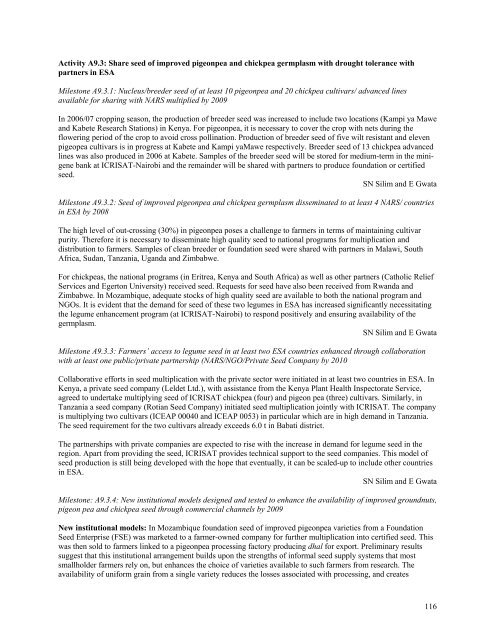ICRISAT Archival Report 2006 - The seedlings of success in the ...
ICRISAT Archival Report 2006 - The seedlings of success in the ...
ICRISAT Archival Report 2006 - The seedlings of success in the ...
You also want an ePaper? Increase the reach of your titles
YUMPU automatically turns print PDFs into web optimized ePapers that Google loves.
Activity A9.3: Share seed <strong>of</strong> improved pigeonpea and chickpea germplasm with drought tolerance with<br />
partners <strong>in</strong> ESA<br />
Milestone A9.3.1: Nucleus/breeder seed <strong>of</strong> at least 10 pigeonpea and 20 chickpea cultivars/ advanced l<strong>in</strong>es<br />
available for shar<strong>in</strong>g with NARS multiplied by 2009<br />
In <strong>2006</strong>/07 cropp<strong>in</strong>g season, <strong>the</strong> production <strong>of</strong> breeder seed was <strong>in</strong>creased to <strong>in</strong>clude two locations (Kampi ya Mawe<br />
and Kabete Research Stations) <strong>in</strong> Kenya. For pigeonpea, it is necessary to cover <strong>the</strong> crop with nets dur<strong>in</strong>g <strong>the</strong><br />
flower<strong>in</strong>g period <strong>of</strong> <strong>the</strong> crop to avoid cross poll<strong>in</strong>ation. Production <strong>of</strong> breeder seed <strong>of</strong> five wilt resistant and eleven<br />
pigeopea cultivars is <strong>in</strong> progress at Kabete and Kampi yaMawe respectively. Breeder seed <strong>of</strong> 13 chickpea advanced<br />
l<strong>in</strong>es was also produced <strong>in</strong> <strong>2006</strong> at Kabete. Samples <strong>of</strong> <strong>the</strong> breeder seed will be stored for medium-term <strong>in</strong> <strong>the</strong> m<strong>in</strong>igene<br />
bank at <strong>ICRISAT</strong>-Nairobi and <strong>the</strong> rema<strong>in</strong>der will be shared with partners to produce foundation or certified<br />
seed.<br />
SN Silim and E Gwata<br />
Milestone A9.3.2: Seed <strong>of</strong> improved pigeonpea and chickpea germplasm dissem<strong>in</strong>ated to at least 4 NARS/ countries<br />
<strong>in</strong> ESA by 2008<br />
<strong>The</strong> high level <strong>of</strong> out-cross<strong>in</strong>g (30%) <strong>in</strong> pigeonpea poses a challenge to farmers <strong>in</strong> terms <strong>of</strong> ma<strong>in</strong>ta<strong>in</strong><strong>in</strong>g cultivar<br />
purity. <strong>The</strong>refore it is necessary to dissem<strong>in</strong>ate high quality seed to national programs for multiplication and<br />
distribution to farmers. Samples <strong>of</strong> clean breeder or foundation seed were shared with partners <strong>in</strong> Malawi, South<br />
Africa, Sudan, Tanzania, Uganda and Zimbabwe.<br />
For chickpeas, <strong>the</strong> national programs (<strong>in</strong> Eritrea, Kenya and South Africa) as well as o<strong>the</strong>r partners (Catholic Relief<br />
Services and Egerton University) received seed. Requests for seed have also been received from Rwanda and<br />
Zimbabwe. In Mozambique, adequate stocks <strong>of</strong> high quality seed are available to both <strong>the</strong> national program and<br />
NGOs. It is evident that <strong>the</strong> demand for seed <strong>of</strong> <strong>the</strong>se two legumes <strong>in</strong> ESA has <strong>in</strong>creased significantly necessitat<strong>in</strong>g<br />
<strong>the</strong> legume enhancement program (at <strong>ICRISAT</strong>-Nairobi) to respond positively and ensur<strong>in</strong>g availability <strong>of</strong> <strong>the</strong><br />
germplasm.<br />
SN Silim and E Gwata<br />
Milestone A9.3.3: Farmers’ access to legume seed <strong>in</strong> at least two ESA countries enhanced through collaboration<br />
with at least one public/private partnership (NARS/NGO/Private Seed Company by 2010<br />
Collaborative efforts <strong>in</strong> seed multiplication with <strong>the</strong> private sector were <strong>in</strong>itiated <strong>in</strong> at least two countries <strong>in</strong> ESA. In<br />
Kenya, a private seed company (Leldet Ltd.), with assistance from <strong>the</strong> Kenya Plant Health Inspectorate Service,<br />
agreed to undertake multiply<strong>in</strong>g seed <strong>of</strong> <strong>ICRISAT</strong> chickpea (four) and pigeon pea (three) cultivars. Similarly, <strong>in</strong><br />
Tanzania a seed company (Rotian Seed Company) <strong>in</strong>itiated seed multiplication jo<strong>in</strong>tly with <strong>ICRISAT</strong>. <strong>The</strong> company<br />
is multiply<strong>in</strong>g two cultivars (ICEAP 00040 and ICEAP 0053) <strong>in</strong> particular which are <strong>in</strong> high demand <strong>in</strong> Tanzania.<br />
<strong>The</strong> seed requirement for <strong>the</strong> two cultivars already exceeds 6.0 t <strong>in</strong> Babati district.<br />
<strong>The</strong> partnerships with private companies are expected to rise with <strong>the</strong> <strong>in</strong>crease <strong>in</strong> demand for legume seed <strong>in</strong> <strong>the</strong><br />
region. Apart from provid<strong>in</strong>g <strong>the</strong> seed, <strong>ICRISAT</strong> provides technical support to <strong>the</strong> seed companies. This model <strong>of</strong><br />
seed production is still be<strong>in</strong>g developed with <strong>the</strong> hope that eventually, it can be scaled-up to <strong>in</strong>clude o<strong>the</strong>r countries<br />
<strong>in</strong> ESA.<br />
SN Silim and E Gwata<br />
Milestone: A9.3.4: New <strong>in</strong>stitutional models designed and tested to enhance <strong>the</strong> availability <strong>of</strong> improved groundnuts,<br />
pigeon pea and chickpea seed through commercial channels by 2009<br />
New <strong>in</strong>stitutional models: In Mozambique foundation seed <strong>of</strong> improved pigeonpea varieties from a Foundation<br />
Seed Enterprise (FSE) was marketed to a farmer-owned company for fur<strong>the</strong>r multiplication <strong>in</strong>to certified seed. This<br />
was <strong>the</strong>n sold to farmers l<strong>in</strong>ked to a pigeonpea process<strong>in</strong>g factory produc<strong>in</strong>g dhal for export. Prelim<strong>in</strong>ary results<br />
suggest that this <strong>in</strong>stitutional arrangement builds upon <strong>the</strong> strengths <strong>of</strong> <strong>in</strong>formal seed supply systems that most<br />
smallholder farmers rely on, but enhances <strong>the</strong> choice <strong>of</strong> varieties available to such farmers from research. <strong>The</strong><br />
availability <strong>of</strong> uniform gra<strong>in</strong> from a s<strong>in</strong>gle variety reduces <strong>the</strong> losses associated with process<strong>in</strong>g, and creates<br />
116

















